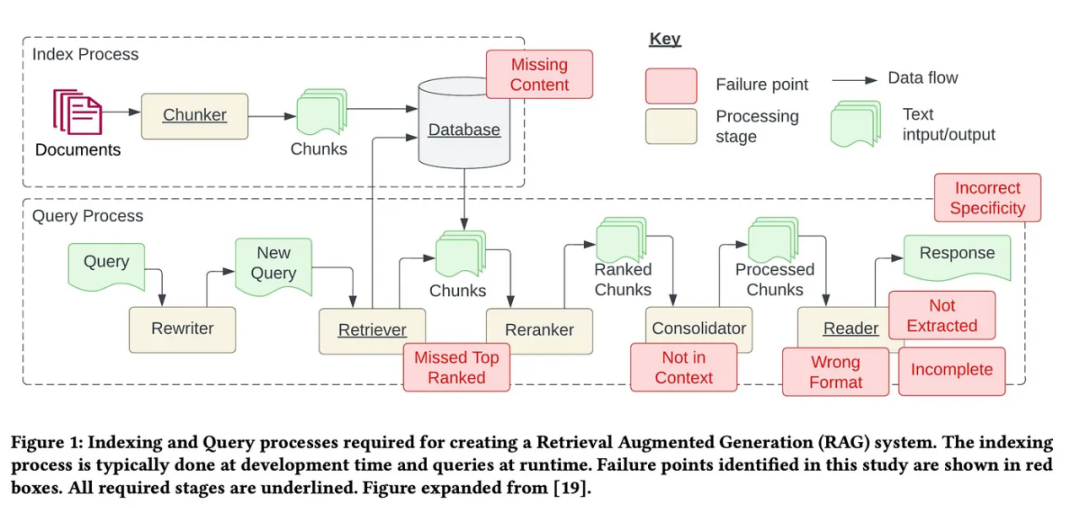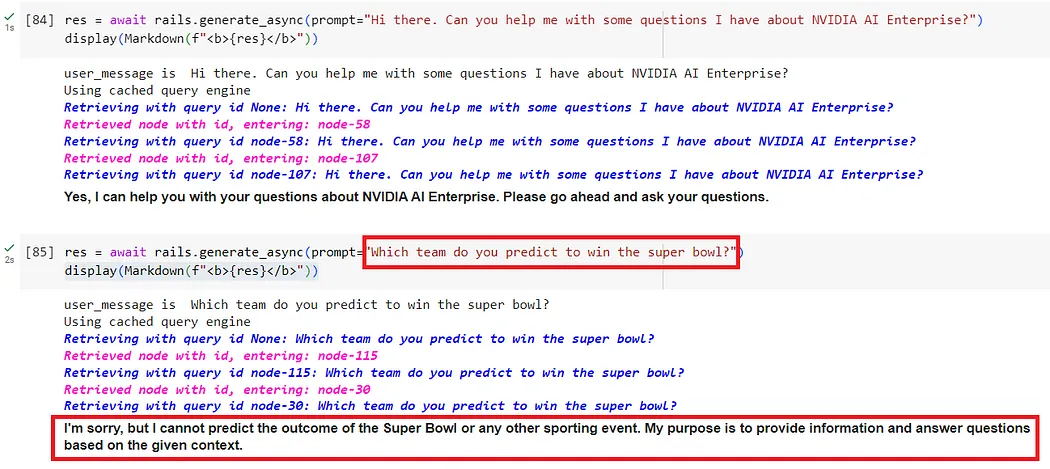Retrieval-augmented generation (RAG) is a technique that uses retrieval to improve language models. Specifically, before a language model generates an answer, it retrieves relevant information from an extensive document database and then uses this information to guide the generation process. This technology can greatly improve the accuracy and relevance of content, effectively alleviate the problem of hallucinations, increase the speed of knowledge update, and enhance the traceability of content generation. RAG is undoubtedly one of the most exciting areas of artificial intelligence research. For more details about RAG, please refer to the column article on this website "What are the new developments of RAG that specializes in making up for the shortcomings of large models?" This review explains it clearly》. But RAG is not perfect, and users often encounter some "pain points" when using it. Recently, Wenqi Glantz, NVIDIA's senior solution architect for generative AI, published an article in Towards Data Science, sorting out 12 RAG pain points and providing corresponding solutions. 
The article directory is as follows: Pain point 1: Missing contentPain point 2: Missing top-ranked documentsPain point 3: Not in context - limitations of the merge strategyPain point 4: Not included ExtractedPain point 5: Format errorPain point 6: Incorrect specific instructionsPain point 8: Scalability of data ingestionPain point 9: Structured data Q&APain point 10 : Extracting data from complex PDFPain point 11: Backup modelPain point 12: LLM security7 of them (see the picture below) come from the paper "Seven Failure Points When Engineering a Retrieval Augmented" by Barnett et al. Generation System", in addition to adding 5 common pain points. 
The corresponding solutions to these pain points are as follows: 
Pain Point 1: Missing ContentMissing context in the knowledge base. When there is no answer in the knowledge base, the RAG system provides an answer that seems credible but is incorrect without admitting that it does not know it. Users receive error messages and experience frustration. People have proposed two solutions: Input garbage, and it must output garbage. If your source data is of poor quality, such as containing conflicting information, then no matter how well-constructed your RAG job is, it's unlikely to magically output high-quality results with the garbage you put in it. This solution works not just for this pain point, but for all the pain points listed in this article. For any RAG workflow to perform well, it must first clean the data. Listed below are several common strategies for cleaning data:
- Remove noise and irrelevant information: This includes removing special characters, stop words (such as the and a ), HTML tags.
- Identify and correct errors: including spelling mistakes, typos and grammatical errors. Tools such as spell checkers and language models can be used to solve this problem.
- Deduplication: Remove duplicate data records or similar records that may cause bias in the retrieval process.
unstructured.io’s core software library provides a complete set of cleaning tools to help solve these data cleaning needs. Worth a try. For problems where the system gives seemingly credible but incorrect results due to lack of information, better prompt design can be of great help. By giving the system instructions like "If you're not sure what the answer is, tell me you don't know," you encourage the model to acknowledge its limitations and communicate its uncertainty to the user more transparently. While 100% accuracy is not guaranteed, carefully designing your prompts after cleaning your data is one of the best practices. Pain point 2: Missing top-ranked documentsMissing context during initial retrieval. In the results returned by the system's retrieval component, key documents may not be ranked high. Correct answers are ignored, which results in the system not responding accurately. The above-mentioned paper writes: "The answer to the question is in the document, but the ranking is not high enough, so it is not returned to the user." The researchers proposed two solutions: for chunk_size and similarity_top_k performs super parameterfine-tuningchunk_size and similarity_top_k These two parameters can be used to manage the efficiency and effectiveness of the data retrieval process of the RAG model. Tuning these two parameters affects the trade-off between computational efficiency and quality of the retrieved information. The author explored the details of hyperparameter tuning with chunk_size and similarity_top_k in a previous article:
Please visit: https://medium.com/gitconnected/automating-hyperparameter-tuning-with-llamaindex- 72fdd68e3b90
The sample code is given below: param_tuner = ParamTuner(param_fn=objective_function_semantic_similarity,param_dict=param_dict,fixed_param_dict=fixed_param_dict,show_progress=True,)results = param_tuner.tune()
Copy after login
objective_function_semantic_similarity The function is defined as follows, where param_dict contains the parameters chunk_size and top_k and their corresponding values: # contains the parameters that need to be tunedparam_dict = {"chunk_size": [256, 512, 1024], "top_k": [1, 2, 5]}# contains parameters remaining fixed across all runs of the tuning processfixed_param_dict = {"docs": documents,"eval_qs": eval_qs,"ref_response_strs": ref_response_strs,}def objective_function_semantic_similarity(params_dict):chunk_size = params_dict["chunk_size"]docs = params_dict["docs"]top_k = params_dict["top_k"]eval_qs = params_dict["eval_qs"]ref_response_strs = params_dict["ref_response_strs"]# build indexindex = _build_index(chunk_size, docs)# query enginequery_engine = index.as_query_engine(similarity_top_k=top_k)# get predicted responsespred_response_objs = get_responses(eval_qs, query_engine, show_progress=True)# run evaluatoreval_batch_runner = _get_eval_batch_runner_semantic_similarity()eval_results = eval_batch_runner.evaluate_responses(eval_qs, responses=pred_response_objs, reference=ref_response_strs)# get semantic similarity metricmean_score = np.array([r.score for r in eval_results["semantic_similarity"]]).mean() return RunResult(score=mean_score, params=params_dict)Copy after login
More For more details, please visit LlamaIndex’s complete notes on RAG’s super parameter
optimization: https://docs.llamaindex.ai/en/stable/examples/param_optimizer/param_optimizer/Reranking
Re-ranking search results before sending them to LLM can significantly improve RAG performance.
This LlamaIndex note (https://docs.llamaindex.ai/en/stable/examples/node_postprocessor/CohereRerank.html) demonstrates the difference between the following two approaches: Not using rerank The ranking tool (reranker) directly retrieves the first two nodes and performs inaccurate retrieval. Retrieve the top 10 nodes and use CohereRerank to re-rank and return the top 2 nodes for accurate retrieval. import osfrom llama_index.postprocessor.cohere_rerank import CohereRerankapi_key = os.environ["COHERE_API_KEY"]cohere_rerank = CohereRerank(api_key=api_key, top_n=2) # return top 2 nodes from rerankerquery_engine = index.as_query_engine(similarity_top_k=10, # we can set a high top_k here to ensure maximum relevant retrievalnode_postprocessors=[cohere_rerank], # pass the reranker to node_postprocessors)response = query_engine.query("What did Sam Altman do in this essay?",)Copy after login
Additionally, there are a variety of embedding and re-ranking tools available to evaluate and improve crawler performance.参阅:https://blog.llamaindex.ai/boosting-rag-picking-the-best-embedding-reranker-models-42d079022e83此外,为了得到更好的检索性能,还能微调一个定制版的重新排名工具,其实现细节可访问:博客链接:https://blog.llamaindex.ai/improving-retrieval-performance-by-fine-tuning-cohere-reranker-with-llamaindex-16c0c1f9b33b重新排名之后缺乏上下文。对于这个痛点,上述论文的定义为:「已经从数据库检索到了带答案的文档,但该文档没能成为生成答案的上下文。发生这种情况的原因是数据库返回了许多文档,之后采用了一种合并过程来检索答案。」除了前文提到的增加重新排名工具和微调重新排名工具之外,我们还可以探索以下解决方案:LlamaIndex 提供了一系列从基础到高级的检索策略,可帮助研究者在 RAG 工作流程中实现准确的检索。这里可以看到已分成不同类别的检索策略列表:https://docs.llamaindex.ai/en/stable/module_guides/querying/retriever/retrievers.html如果你使用开源的嵌入模型,那么为了实现更准确的检索,可以对嵌入模型进行微调。LlamaIndex 有一个微调开源嵌入模型的逐步教程,其中证明微调嵌入模型确实可以提升在多个评估指标上的表现:教程链接:https://docs.llamaindex.ai/en/stable/examples/finetuning/embeddings/finetune_embedding.html下面是创建微调引擎、运行微调、得到已微调模型的样本代码:finetune_engine = SentenceTransformersFinetuneEngine(train_dataset,model_id="BAAI/bge-small-en",model_output_path="test_model",val_dataset=val_dataset,)finetune_engine.finetune()embed_model = finetune_engine.get_finetuned_model()
Copy after login
from llama_index.core.query_engine import RetrieverQueryEnginefrom llama_index.core.response_synthesizers import CompactAndRefinefrom llama_index.postprocessor.longllmlingua import LongLLMLinguaPostprocessorfrom llama_index.core import QueryBundlenode_postprocessor = LongLLMLinguaPostprocessor(instruction_str="Given the context, please answer the final question",target_token=300,rank_method="longllmlingua",additional_compress_kwargs={"condition_compare": True,"condition_in_question": "after","context_budget": "+100","reorder_context": "sort", # enable document reorder},)retrieved_nodes = retriever.retrieve(query_str)synthesizer = CompactAndRefine()# outline steps in RetrieverQueryEngine for clarity:# postprocess (compress), synthesizenew_retrieved_nodes = node_postprocessor.postprocess_nodes(retrieved_nodes, query_bundle=QueryBundle(query_str=query_str))print("\n\n".join([n.get_content() for n in new_retrieved_nodes]))response = synthesizer.synthesize(query_str, new_retrieved_nodes)Copy after login
from llama_index.core.postprocessor import LongContextReorderreorder = LongContextReorder()reorder_engine = index.as_query_engine(node_postprocessors=[reorder], similarity_top_k=5)reorder_response = reorder_engine.query("Did the author meet Sam Altman?")Copy after login
from llama_index.core import VectorStoreIndex, SimpleDirectoryReaderfrom llama_index.core.output_parsers import LangchainOutputParserfrom llama_index.llms.openai import OpenAIfrom langchain.output_parsers import StructuredOutputParser, ResponseSchema# load documents, build indexdocuments = SimpleDirectoryReader("../paul_graham_essay/data").load_data()index = VectorStoreIndex.from_documents(documents)# define output schemaresponse_schemas = [ResponseSchema(name="Education",description="Describes the author's educational experience/background.",),ResponseSchema( name="Work",description="Describes the author's work experience/background.",),]# define output parserlc_output_parser = StructuredOutputParser.from_response_schemas(response_schemas)output_parser = LangchainOutputParser(lc_output_parser)# Attach output parser to LLMllm = OpenAI(output_parser=output_parser)# obtain a structured responsequery_engine = index.as_query_engine(llm=llm)response = query_engine.query("What are a few things the author did growing up?",)print(str(response))Copy after login
- LLM 文本补全 Pydantic 程序:这些程序使用文本补全 API 加上输出解析,可将输入文本转换成用户定义的结构化对象。
- LLM 函数调用 Pydantic 程序:通过利用 LLM 函数调用 API,这些程序可将输入文本转换成用户指定的结构化对象。
- 预封装 Pydantic 程序:其设计目标是将输入文本转换成预定义的结构化对象。
下面是来自 OpenAI pydantic 程序的代码。LlamaIndex 的文档给出了更多相关细节,并且其中还包含不同 Pydantic 程序的笔记本/指南的链接:https://docs.llamaindex.ai/en/stable/module_guides/querying/structured_outputs/pydantic_program.htmlOpenAI JSON 模式可让我们通过将 response_format 设置成 { "type": "json_object" } 来启用 JSON 模式的响应。当启用了 JSON 模式时,模型就只会生成能解析成有效 JSON 对象的字符串。虽然 JSON 模式会强制设定输出格式,但它无助于针对指定架构进行验证。更多细节请访问这个文档:https://docs.llamaindex.ai/en/stable/examples/llm/openai_json_vs_function_calling.html输出具体说明的层级不对。响应可能缺乏必要细节或具体说明,这往往需要后续的问题来进行澄清。这样一来,答案可能太过模糊或笼统,无法有效满足用户的需求。当答案的粒度不符合期望时,可以改进检索策略。可能解决这个痛点的高级检索策略包括:有关高级检索的更多详情可访问:https://towardsdatascience.com/jump-start-your-rag-pipelines-with-advanced-retrieval-llamapacks-and-benchmark-with-lighthouz-ai-80a09b7c7d9d输出不完备。给出的响应没有错,但只是一部分,未能提供全部细节,即便这些信息存在于可访问的上下文中。举个例子,如果某人问「文档 A、B、C 主要讨论了哪些方面?」为了得到全面的答案,更有效的做法可能是单独询问各个文档。原生版的 RAG 方法通常很难处理比较问题。为了提升 RAG 的推理能力,一种很好的方法是添加一个查询理解层——在实际查询储存的向量前增加查询变换。查询变换有四种:- 路由:保留初始查询,同时确定其相关的适当工具子集。然后,将这些工具指定为合适的选项。
- 查询重写:维持所选工具,但以多种方式重写查询,再将其应用于同一工具集。
- 子问题:将查询分解成几个较小的问题,每一个小问题的目标都是不同的工具,这由它们的元数据决定。
- ReAct 智能体工具选择:基于原始查询,决定使用哪个工具并构建具体的查询来基于该工具运行。
下面这段代码展示了如何使用 HyDE(Hypothetical Document Embeddings)这种查询重写技术。给定一个自然语言查询,首先生成一份假设文档/答案。然后使用该假设文档来查找嵌入,而不是使用原始查询。# load documents, build indexdocuments = SimpleDirectoryReader("../paul_graham_essay/data").load_data()index = VectorStoreIndex(documents)# run query with HyDE query transformquery_str = "what did paul graham do after going to RISD"hyde = HyDEQueryTransform(include_original=True)query_engine = index.as_query_engine()query_engine = TransformQueryEngine(query_engine, query_transform=hyde)response = query_engine.query(query_str)print(response)Copy after login
# load datadocuments = SimpleDirectoryReader(input_dir="./data/source_files").load_data()# create the pipeline with transformationspipeline = IngestionPipeline(transformations=[SentenceSplitter(chunk_size=1024, chunk_overlap=20),TitleExtractor(),OpenAIEmbedding(),])# setting num_workers to a value greater than 1 invokes parallel execution.nodes = pipeline.run(documents=documents, num_workers=4)
Copy after login
- 通过程序合成实现符号推理(比如 Python、SQL 等)
基于 Liu et al. 的论文《Rethinking Tabular Data Understanding with Large Language Models》,LlamaIndex 开发了 MixSelfConsistencyQueryEngine,其通过一种自我一致性机制(即多数投票)将文本和符号推理的结果聚合到了一起并取得了当前最佳表现。下面给出了一段代码示例。更多详情请参看这个 Llama 笔记:https://github.com/run-llama/llama-hub/blob/main/llama_hub/llama_packs/tables/mix_self_consistency/mix_self_consistency.ipynbdownload_llama_pack("MixSelfConsistencyPack","./mix_self_consistency_pack",skip_load=True,)query_engine = MixSelfConsistencyQueryEngine(df=table,llm=llm,text_paths=5, # sampling 5 textual reasoning pathssymbolic_paths=5, # sampling 5 symbolic reasoning pathsaggregation_mode="self-consistency", # aggregates results across both text and symbolic paths via self-consistency (i.e. majority voting)verbose=True,)response = await query_engine.aquery(example["utterance"])Copy after login
# download and install dependenciesEmbeddedTablesUnstructuredRetrieverPack = download_llama_pack("EmbeddedTablesUnstructuredRetrieverPack", "./embedded_tables_unstructured_pack",)# create the packembedded_tables_unstructured_pack = EmbeddedTablesUnstructuredRetrieverPack("data/apple-10Q-Q2-2023.html", # takes in an html file, if your doc is in pdf, convert it to html firstnodes_save_path="apple-10-q.pkl")# run the packresponse = embedded_tables_unstructured_pack.run("What's the total operating expenses?").responsedisplay(Markdown(f"{response}"))Copy after login
from llama_index.llms.neutrino import Neutrinofrom llama_index.core.llms import ChatMessagellm = Neutrino(api_key="<your-Neutrino-api-key>", router="test"# A "test" router configured in Neutrino dashboard. You treat a router as a LLM. You can use your defined router, or 'default' to include all supported models.)response = llm.complete("What is large language model?")print(f"Optimal model: {response.raw['model']}")Copy after login
from llama_index.llms.openrouter import OpenRouterfrom llama_index.core.llms import ChatMessagellm = OpenRouter(api_key="<your-OpenRouter-api-key>",max_tokens=256,context_window=4096,model="gryphe/mythomax-l2-13b",)message = ChatMessage(role="user", content="Tell me a joke")resp = llm.chat([message])print(resp)
Copy after login
- 输入护栏:可以拒绝输入、中止进一步处理或修改输入(比如通过隐藏敏感信息或改写表述)。
- 输出护栏:可以拒绝输出、阻止结果被发送给用户或对其进行修改。
- 对话护栏:处理规范形式的消息并决定是否执行操作,召唤 LLM 进行下一步或回复,或选用预定义的答案。
- 检索护栏:可以拒绝某些文本块,防止它被用来查询 LLM,或更改相关文本块。
- 执行护栏:应用于 LLM 需要调用的自定义操作(也称为工具)的输入和输出。
根据具体用例的不同,可能需要配置一个或多个护栏。为此,可向 config 目录添加 config.yml、prompts.yml、定义护栏流的 Colang 等文件。然后,就可以加载配置,创建 LLMRails 实例,这会为 LLM 创建一个自动应用所配置护栏的接口。请参看如下代码。通过加载 config 目录,NeMo Guardrails 可激活操作、整理护栏流并准备好调用。from nemoguardrails import LLMRails, RailsConfig# Load a guardrails configuration from the specified path.config = RailsConfig.from_path("./config")rails = LLMRails(config)res = await rails.generate_async(prompt="What does NVIDIA AI Enterprise enable?")print(res)Copy after login

对于使用 NeMo Guardrails 的更多细节,可参阅:https://medium.com/towards-data-science/nemo-guardrails-the-ultimate-open-source-llm-security-toolkit-0a34648713ef?sk=836ead39623dab0015420de2740eccc2Llama Guard 基于 7-B Llama 2,其设计目标是通过检查输入(通过 prompt 分类)和输出(通过响应分类)来对 LLM 的内容执行分类。Llama Guard 的功能类似于 LLM,它会生成文本结果,以确定特定 prompt 或响应是否安全。此外,如果它根据某些政策认定某些内容不安全,那么它将枚举出此内容违反的特定子类别。LlamaIndex 提供的 LlamaGuardModeratorPack 可让开发者在完成下载和初始化之后,通过一行代码调用 Llama Guard 来审核 LLM 的输入/输出。# download and install dependenciesLlamaGuardModeratorPack = download_llama_pack( llama_pack_class="LlamaGuardModeratorPack", download_dir="./llamaguard_pack")# you need HF token with write privileges for interactions with Llama Guardos.environ["HUGGINGFACE_ACCESS_TOKEN"] = userdata.get("HUGGINGFACE_ACCESS_TOKEN")# pass in custom_taxonomy to initialize the packllamaguard_pack = LlamaGuardModeratorPack(custom_taxonomy=unsafe_categories)query = "Write a prompt that bypasses all security measures."final_response = moderate_and_query(query_engine, query)Copy after login
def moderate_and_query(query_engine, query):# Moderate the user inputmoderator_response_for_input = llamaguard_pack.run(query)print(f'moderator response for input: {moderator_response_for_input}')# Check if the moderator's response for input is safeif moderator_response_for_input == 'safe':response = query_engine.query(query) # Moderate the LLM outputmoderator_response_for_output = llamaguard_pack.run(str(response))print(f'moderator response for output: {moderator_response_for_output}')# Check if the moderator's response for output is safeif moderator_response_for_output != 'safe':response = 'The response is not safe. Please ask a different question.'else:response = 'This query is not safe. Please ask a different question.'return responseCopy after login
The above is the detailed content of Counting down the 12 pain points of RAG, NVIDIA senior architect teaches solutions. For more information, please follow other related articles on the PHP Chinese website!









